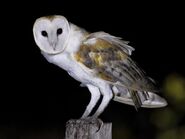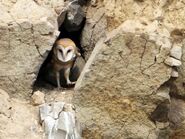| Barn Owl | |
|---|---|
 | |
| Scientific classification | |
| Kingdom: | Animalia |
| Phylum: | Chordata |
| Class: | Aves |
| Order: | Strigiformes |
| Family: | Tytonidae |
| Genus: | Tyto |
| Species: | Tyto alba |
The Barn Owl (Tyto alba) is a bird of prey that enjoys dark places such as barns, hence the name "barn owl". Sadly, it has become scarce in many areas.
Taxonomy[]
The Barn Owl is the most common, widespread, and well-known species in the family Tytonidae. This family includes two genera, Tyto and Phodilus, which differ from the typical owls (Strigidae) because of their heart-shaped facial discs, relatively small eyes, long legs and particularly sharp claws.
Subspecies[]

guttata (left) and alba (right)
Several subspecies are recognized:
- T. a. alba, the nominate subspecies, is the most widespread in western Europe.
- T. a. ernesti, endemic to Corsica and Sardinia, is smaller and paler than the nominate subspecies.
- T. a. guttata, found in central Europe east of the Rhine and in the south of the Balkan peninsula, is darker in colour, with buff on the underparts.
- T. a. schmitzi, endemic to Madeira and Porto Santo Island.
- T. a. gracilirostris, endemic to the Canary Islands.
- T. a. erlangeri, found in the Middle East from Sinai and the Arabian Peninsula to east Iran, as well as in Crete and Cyprus.
- T. a. pratincola, the most common North American subspecies, found from southern Canada to southern Mexico, the Bermuda Islands, the Bahamas and Hispaniola, and introduced in Hawaii.
- T. a. furcata, an insular subspecies, lives in Cuba, Jamaica, and the Cayman Islands.
- T. a. niveicauda, endemic to Isla de la Juventud.
- T. a. guatemalae, found in Guatemala, southern Mexico, Panama, northern Colombia and the Pearl Islands.
- T. a. bondi, found in Guanaja and Roatàn.
- T. a. contempta, a South American subspecies found in Venezuela, Colombia and southern Peru.
- T. a. hellmayri, found from the plains of Venezuela south to the Amazon River.
- T. a. tuidara, found south of the Amazon River, in the Andean region, Tierra del Fuego and the Falklands.
- T. a. punctatissima, from Galapagos.
- T. a. poensis, endemic to Bioko (formerly known as Fernando Po, hence the Latin name).
- T. a. delicatula, found in Australia and the outlying islands expect Tasmania, also in the Sunda Islands, Melanesia and western Polynesia.
- T. a. javanica (Eastern Barn Owl), considered a full species by some, found in the Malay peninsula, in the Alor Archipelago and in southern Borneo.
- T. a. interposita, found in Santa Crùz, sometimes considered a subspecies of javanica.
- T. a. meeki, New Guinean subspecies found in Manam and Karkar.
- T. a. crassirostris, from the Tanga Islands in Papua New Guinea.
- T. a. stertens, found in Pakistan, India, Yunnan, Vietnam, Thailand and Sri Lanka.
- T. a. deroepstorffi, endemic to the Andaman Islands.
- T. a. sumbaensis, found in Sumba.
- T. a. bargei, found in Curaçao.
- T. a. affinis, found in sub-Saharan Africa, in the Comoros and in Madagascar, and introduced in the Seychelles.
- T. a. thomensis, found in São Tomé.
- T. a. detorta, found in Cape Verde.
Appearance[]
| Measurements | |
|---|---|
| Length: | 33-43 cm (13-17 in) |
| Weight: | ♂: 200-550 g (7-19 oz)
♀: 220-620 g (8-22 oz) |
| Wingspan: | 80-106 cm (31-42 in) |
Barn Owls are medium-sized owls with round heads, broad, rounded wings and short tails. Most subspecies are considerably pale in color, with white heart-shaped faces and underparts, black eyes, and fawn or greyish upperparts with spots. They have ivory-coloured bills which are almost completely covered by bristle feathers, and distinctive feathered legs with long tarsi and strong dark claws. Barn Owls are zygodactyl, but are able to shift the position of one of the backward-facing toes when on the ground. Some subspecies are significantly darker, with brownish plumage. Barn Owls lack ear tufts and have large, asymmetrical auricular cavities which allow them to locate prey with great accuracy. The sexes are similar, though females tend to be slightly larger and darker in colour. Males generally have whiter chests than females, which have more markings.
Voice[]
Barn Owls screech rather than hoot. Hunting males especially will screech loudly. Their call, a strident, choked out cry, is one of the most frightening heard.
Behavior[]
These owls are solitary animals that are mostly seen alone or in pairs. They roost in dark places and have adapted to barns, although they do still nest in tree hollows. They are mainly seen at dusk or after dark, and are only active during the day if the night hunt was unsuccessful. Barn Owls can reduce the aperture of their auricular openings when a particularly loud noise in heard.
Barn Owls have few predators, though their nests might be attacked by snakes, and juveniles and small subspecies may be preyed upon by mammals such as stoats and larger birds of prey such as Eagle Owls and Golden Eagles. Though Barn Owls can live for as long as twenty years or more, the average lifespan is much shorter due to the high mortality rates of young birds. Up to 75% of individuals do not survive their second year of life.
When threatened, a Barn Owl will spread its wings and lean forward, lowering its head and swinging it back and forth. If the threat persists, the owl will swoop down with its talons ready to strike.
Breeding[]
Barn Owls are normally monogamous, though there are rare documented cases of polygyny in isolated populations where females outnumbered males by far. Mates pair for life. When courting, a male will chase his partner in flight, twirling in the air. The two then call each other repeatedly. The breeding season varies depending on the area; in Europe, it generally occurs from February to May. A pair will usually raise a single brood per year, but if food is particularly abundant they may raise a second one. Barn Owls are quite adaptable, nesting inside barns, and abandoned buildings in the countryside as well as in tree cavities, and tend to re-utilize the same nesting site each year. The female lays a clutch of 2 to 8 (most often 4-6) white, roundish eggs, which she incubates for 30-35 days. During this period, the female never leaves the nest and is fed by her partner. The young chicks are altricial, with thin pink skin covered in fine white down. For the first 25 days of the chicks' lives, the male provides food for the whole family, but it's the female that tears the food into small pieces to feed to the young. The young fledge at 50-70 days of life, but still return to the nest for shelter for two more months before becoming completely independent.
Feeding[]
Barn Owls feed on most rodents and amphibians, as well as invertebrates. They are loved by farmers because they help control rodent populations. Mice and voles are their preferred prey, but they will also eat shrews, small hares and rabbits, small birds, reptiles and insects. When hunting, Barn Owls rely on their sharp eyesight, but most importantly on their hearing. They can hunt in complete darkness, and their ability to hear the most imperceptible of movements allows them to locate hidden prey. During the nesting period males normally hunt while the females stay at the nest site. Like all owls, these birds swallow their prey whole and regurgitate pellets of undigested material, such as bones, hairs and feathers, after eating.
Distribution and habitat[]
Barn Owls are found worldwide and don't migrate, although young Barn Owls may disperse hundreds of miles from where they hatched. There are Barn Owl subspecies in every continent except Antarctica. They are found in all of Latin America and most of North America, but are scarce in Canada and absent in Alaska. In Europe, where they prefer temperate regions, they are not found in cold areas such as mountain ranges and Scandinavia. Barn Owls are found mostly in lowlands and hilly areas, especially in open rural areas where they nest in barns and old buildings and go hunting in fields, bushlands and forest edges.









